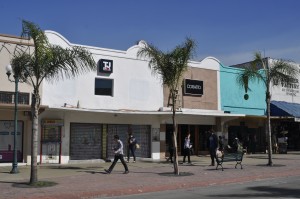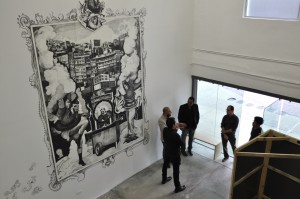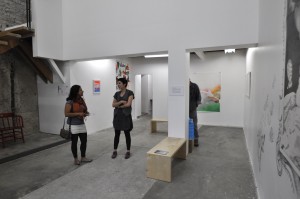Jammed in the corner of the republic, up against the border wall with San Diego, Tijuana can feel a little claustrophobic.
Not everybody sees it this way, of course. Tijuana’s condition as a border city has been celebrated in more expansive terms in recent decades as a city that thrives on multiplicity. A city that generates fragmentation and paradox. A city that is both defined by the binary logic of self/Other and transcends it. A transborder metropolis.
TJ in China Project Space, a new gallery and project space run by Mely Barragan and Daniel Ruanova, takes up the problem of the aesthetics of place as its raison d’être. Located in downtown Tijuana on the old familiar tourist strip of Avenida Revolución (between 6th & 7th), but oriented along the axis Tijuana-China, Barragan and Ruanova break with Tijuana’s old orientation toward the United States and instead consciously resituate Tijuana within the global contemporary art world.
In the context of the current competition among world cities to entice only the most hip and sophisticated of the new international migrant class, the very elasticity of Tijuana’s image as border city can easily become an imprisoning metaphor,
As David Harvey reminds us, the world system of capitalism thrives on a time-space compression in which some localized aesthetic image of a place is easily defined and marketed by postmodern regimes and codes of capitalist accumulation. As a border city, Tijuana has profited and suffered in equal measure from its north-south orientation, its tawdry temptations eagerly supplied by investors to satisfy the appetites of southern Californians.
It is clear that “old Tijuana” as a strategy of accumulation has lost its purchase, and in its place city leaders hope to revive tourism along more sophisticated lines, featuring regional cuisine, our gorgeous Valle de Guadalupe wine region and an emergent downtown gallery scene.
Yet the “new Tijuana” hasn’t quite jelled into a delible image. And it remains to be seen how a new Tijuana will advance the interests and genuine cultural diversity of all of its residents in both the Centro and its colonias.

TJ in China Project Room, Av. Revolución No. 1332, Zona Centro, Tijuana, BC, MEXICO (entre 6ta Y 7ma)
What’s refreshing about Barragan and Ruanova’s project is that they hope to illuminate these new cultural forms and practices by linking Tijuana with other cities experiencing the same conditions of rapid transformation generated by global flows of capital and migration.
After living in Beijing running a gallery space there, Barragan and Ruanova have returned to Tijuana with a new perspective on borders and Tijuana’s identity.
In an interview published on YouTube, Ruanova explains how the project emerged out of a desire to understand:
We believe that what we are doing in China is to build a human connection between there and here, based in knowing, seeing and understanding each other.
The “Project Room” will be an amalgam of ideas and projects formed out of objects, projections, actions… A mutation in constant transition where ideas and new intrusions (“intrusos-nuevos”) change the present and the future of what is exhibited, and give new meaning to the past to “tweek” history, something like the dynamics that govern our border region” (Ruanova).
Creemos que lo que hacemos en China es construir un enlace humano entre allá y acá en base a conocernos, a vernos y a comprendernos.
El “project room” será una amalgama de ideas en proyectos formado por objetos, proyecciones, acciones, etc… Un mutante en constante transición en donde las ideas y los “intrusos-nuevos” cambian el presente y futuro de lo expuesto y re-semantiza el pasado al “tuiquear” la historia, algo así como las dinámicas que imperan en nuestra frontera.
The current show, “Paisaje Urbano de un Presente Bizarro/Urbanscape from a Bizarre Present,” engages directly with the mutations and transformations of the urban built environment. Featuring Corrie Slawson & Marc Lefkowitz (Cleveland/USA), Hugo Crosthwaite (Borderlands/Mexico), Luis G. Hernandez (Sur de California/USA-Mexico) and Pepe Mogt (Tijuana/Mexico), the show brings together artists from disparate locations on the global grid, and whose lives and work are marked by multiple migrations.
The work of Slawson and Lefkowitz is particularly interesting here: the Cleveland couple completed a residency in Tijuana, living here and experiencing Tijuana both as artists and as parents with their three-year old son, Ira in tow. The resulting work examines Tijuana’s visual language and built environment through Slawson’s signature screen print works and Lefkowitz’s blog Green City Blue Lake, which he produces for the Cleveland Museum of Natural History. Known for her work examining place and space, informed by land use and community life cycles, Slawson’s impressionistic screen print works were produced from cell phone photos taken while walking around Tijuana. Clawson uses bright neon colors to engage with the color and visual style of Tijuana’s urban streets, and to channel her shock at the brutality of the border wall.
Crosthwaite’s tremendous mural, painted on the south wall of the gallery space, engages with images of the old and new Tijuana. And Hernandez’s pieces engage with the dynamics of gallery space and play with the expectations of the visitor.
In the early 90s, cultural theorist Fredric Jameson argued for new readings of cultural objects based on precisely this kind of dislocation and relocation of the local. Borrowing from urban theorist Kevin Lynch, Jameson suggested that new practices of “cognitive mapping” would be “a necessary postmodern strategy for locating and actualizing geopolitical orientation, that provides one model of for how we might begin to articulate the global and the local. It provides a way of linking the most intimately local–our particular path through the world–and the most global–the crucial features of our political planet” (Colin MacCabe in his introduction to The Geopolitical Aesthetic, 1992).
TJ in China Project Space appears to have accomplished a new cognitive mapping of Tijuana in the world, one which may illuminate rather than obscure the totality of social relations under globalization, mapping new roads for artists and Tijuanenses to follow.
****************
The current show, “Paisaje Urbano de un Presente Bizarro/Urbanscape from a Bizarre Present,” will close Thursday, May 29, with a panel discussion beginning at 7:00 PM featuring two of the artists, Hugo Crosthwaite and Luis G. Hernandez. For more detail, see the invitation on Facebook. This would be a great time to check out the gallery, don’t you think?


